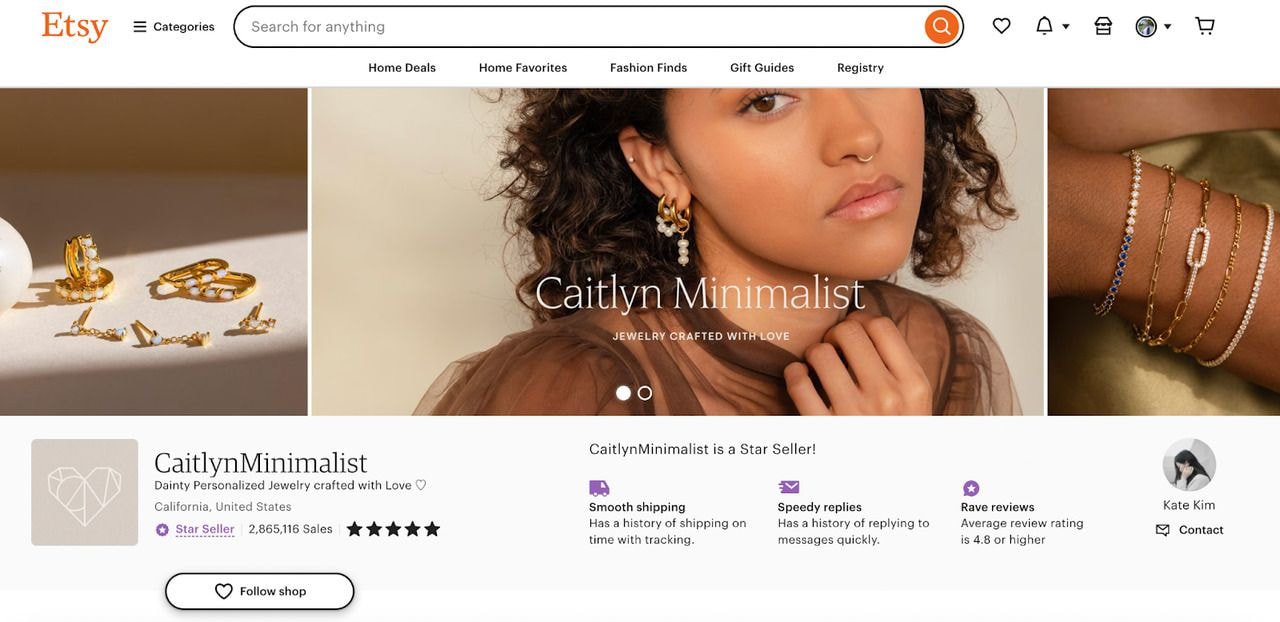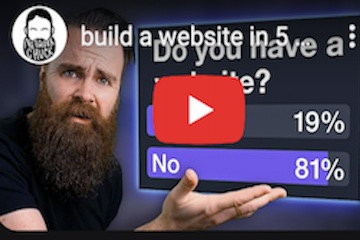
For over a decade, Etsy has been the go-to marketplace for one-of-a-kind gifts and original clothing. It’s the first brand name that comes to many shoppers’ minds when they search for something personalized or handmade.
Also, from a new seller’s perspective, Etsy is seen as a paradise due to its massive growth in terms of customer pool, mainly thanks to the global pandemic (+78% in 2020). If you’re a small business owner who sells custom goods, you, too, have probably considered joining the Etsy seller cohort.
Yet, with other ecommerce opportunities easily accessible and many sellers starting to question the platform’s future, you may also wonder—is selling on Etsy worth it in 2024?
To help you understand which direction may benefit your online business the most, let’s see how Etsy stacks up against the most common alternative—having your own online store.
What to expect from Etsy in 2024
Despite its dominance in the custom goods scene, Etsy is still a niche ecommerce platform compared to other major industry players like Amazon, WooCommerce, or Shopify. In 2023, its market share reached 0.13%, and over half of the store owners were based in the USA.
Like the rest of online marketplaces, Etsy experienced its most notable surge during the pandemic. And while the buyer stats have stagnated around 95–96 million for now, the number of active Etsy sellers, after a small decline in 2022, increased by 21% last year, promising growth this year, too.
The best Etsy sellers reach tens of thousands of monthly sales, with jewelry seller CaitlynMinimalist at the top and surpassing the 60k mark.

The vast majority of active Etsy buyers are female. But, according to the company’s annual report, the male user base has grown rapidly over the past few years. This means you could potentially gain more traffic by tapping into the less saturated part of Etsy. Just remember that some products for men, for example, couple’s t-shirts, will still be mainly purchased by women as gifts.
Age is another factor to consider when thinking about who to target with your store. Almost half of Etsy visitors are aged 18–34, so your best bet this year is to design products that appeal to young adults, young professionals, and also parents of small children.

Jewelry, craft supplies, paper products, and weddings are the top-selling Etsy categories that will likely remain popular and quite competitive in 2024, as well. On top of that, household and wellness items have gained traction, appearing in more and more top-rated Etsy listings, and present great potential for you to tap into.


@media (max-width:768px)
.pf-btn-lg height: 40px; line-height: 38px; min-width: 88px; font-size: 16px;
Is selling on Etsy worth it in 2024?
Yes, selling on Etsy is worth it in 2024, especially if you combine it with other sales channels, like your own website and social media platforms. The marketplace gives you access to thousands of customers as soon as you set up your Etsy store.
Etsy also lets you sell handmade or custom-made items exclusively, protecting you and other Etsy sellers from the competition of big brands.
How hard is it to sell on Etsy?
You can launch an Etsy shop in a few simple steps. A more complex question is deciding what to sell on Etsy and how to do it, as you’ll need to crack the Etsy algorithm and SEO code to run a successful Etsy shop.

Partnering with a print-on-demand company like Printful and taking advantage of the Etsy dropshipping option can simplify the selling process by a mile. You can focus on designing and marketing your products while others take care of production, storage, and delivery for you.
Pro tip: Get the best lifehacks on selling on Etsy in our guide How to Succeed on Etsy
Pros of selling on Etsy
By allowing only original and custom items, Etsy presents itself as a unique online marketplace—the largest one in this niche worldwide.
Aside from giving a platform for artists and small business owners to showcase their designs to the global customer, Etsy boasts several other benefits when compared to selling products on your own website or other Etsy alternatives.
1. Access to a huge audience
The large customer pool is the main reason people open an Etsy store. The number of active Etsy buyers has come close to 100 million over the past few years, which is a substantial result even next to Amazon’s 300 million users.
When starting your own online store, you’ll need to build the audience from scratch. And unless you have a strong social media presence and brand, it’ll take a lot more time and financial resources than attracting the attention of the existing Etsy customers.

2. Quick and easy set-up
Setting up an Etsy shop takes less than 10 minutes. You don’t need advanced tech knowledge or pay monthly or annual fees to create a seller account. You’ll be charged only when you want to start selling on Etsy and publish your first Etsy listing.

Suppose you opt for your own online store, in turn. In that case, you’ll need to either find a website designer or invest your own time in designing a store using one of the available website building and hosting companies, like Squarespace, WordPress, or Shopify. Plus, you’ll need to pay for the store even if you sell nothing there.
The easy Etsy set-up process also allows you to test product ideas. Some Etsy categories, like digital products, have a relatively low barrier to entry, so you can quickly identify trending products that could be sold in other sales channels without a large upfront investment.
Pro tip: Learn more about launching an Etsy store in our guide How to Sell on Etsy
3. Low starting costs
Like all other marketplaces, it costs money to sell on Etsy, too. However, Etsy listing fees are significantly lower than what the competition asks of their users. For example, Amazon Handmade deducts a 15% referral fee from every sale, while Etsy charges 0.20 USD for every published listing.
You don’t need a considerable upfront investment to start an Etsy business. However, if you opt for your own online store, you’ll need to pay for the design, hosting, and domain name of the website way before you have anything to show to your potential customers.
Mastering Etsy SEO will also help you get noticed without significant extra costs. Plus, Etsy’s algorithm doesn’t change as often and doesn’t have as many elements as that of Google or social media, making it easier to get in front of the right audience and remain there for a while.
4. Multiple marketing opportunities
Designing products and listing them on Etsy is quick and simple. Marketing and selling them successfully is the real art. Fortunately, Etsy offers several marketing tools within the site and outside of it to bring more customers to your Etsy shop.
From Etsy ads, discounts, and free shipping campaigns to Etsy offsite ads and integrations with social media accounts—there’s a lot you can do following the Etsy promotion guide, even if you’re not a marketing guru.

While advertising on Etsy takes time and practice to gain the desired results, your own website will require much more effort and resources, and most likely a marketing specialist to gain traction on Google or social media.
5. Extensive learning resources
One of the less-seen and talked-about benefits of selling on Etsy is its vast collection of useful resources. In the Etsy Seller Handbook, you can learn anything from search engine optimization for your Etsy listings to building audience and content strategy.
Apart from built-in Etsy seller resources, you can also take advantage of many online courses and other free or paid analytics tools, like EtsyHunt, eRank, or Alura, to do market research and optimize your listings.

Etsy also has a separate community page, including a forum, making it easier to collaborate with other Etsy sellers and tap into their knowledge bank. When you’re on your own, it’s considerably harder to get the community feel, and you would need to look for dedicated online or physical spaces and events to connect with fellow sellers.
Cons of selling on Etsy
While Etsy may appear as a golden opportunity for small business owners who sell handmade products or vintage items, everything isn’t as ideal as it seems.
The marketplace is easy to use with a low barrier to entry. Yet, there are also a lot of rules you should consider, and increasing competition, which can significantly impact your chances of reaching profitability.
1. Numerous Etsy seller fees
Even though launching a product on Etsy costs less than a dollar, it’s not the only fee you’ll have to cover as an Etsy business owner. In fact, experienced platform users have complained about increasing Etsy seller fees that’ll likely grow in the future and result in lower profit margins.
For every listing you publish on Etsy, you have to cover the following costs:
-
Listing fee—0.20 USD per item
-
Transaction fee—6.5% of your item’s price for every sale you make
-
Payment processing fee—for each transaction processed through Etsy Payments (depends on the gross order amount)
-
Shipping fees—you’re responsible for paying for the delivery of physical goods (can be covered by the buyer if you don’t use the “free shipping” option)
-
Advertising fees—this is an additional expense you have to consider if you want to run Etsy Ads or offsite ads (depending on your budget)
Aside from the fees listed above, you may also pay 10 USD monthly to get the Etsy Plus package and unlock more tools.

2. Tough competition
While the big international brands can’t enter Etsy, it doesn’t mean there’s no competition. In 2023, there were over 9 million active sellers in total. Some categories are particularly saturated, making it more difficult, but not impossible to stand out. For example, the keyword “custom mugs” alone brings thousands of similar listings.

The fierce competition is what drives many potential sellers to wonder—is selling on Etsy worth it? First, you must constantly monitor the prices and run promotions to stay on top. Second, even your original, one-of-a-kind designs can’t be fully protected from copycats that feed off your popularity and sell the same idea for a lower price.
Of course, you’re susceptible to idea theft even if you sell online outside of Etsy. Yet the platform makes it easy for other sellers to identify top-rated products through Etsy reviews or “Popular now” and “Bestseller” badges.
Pro tip: Learn more about running a successful Etsy shop in our guide How to Make Money on Etsy


@media (max-width:768px)
.pf-btn-lg height: 40px; line-height: 38px; min-width: 88px; font-size: 16px;
3. Influx of mass-produced items
What used to be purely a platform for artists, craftsmen, and collectors to showcase their exceptional creations is now overflown with non-handmade and factory-produced items in many Etsy categories. This pushes the price down and makes it harder for small local artisans to remain competitive.
Several community members have even complained on Etsy forums that some products are falsely labeled as “locally made” while in fact, they’re just resold and also available in AliExpress or other online retailers.
You should remember that Etsy doesn’t allow reselling (unless it’s a vintage item or craft supplies), and it takes time to ban everyone who’s broken this rule. However, you can outsource a production partner, as in the case of a print-on-demand company, as long as you design the product yourself.
4. Limited brand control
When you create and run your own website, you have complete freedom to choose how it looks and functions. Etsy shops, in turn, don’t have the same customization and branding possibilities—you have to play by the rules the platform sets.
Changing the banner and shop description is the only way to make a more personalized storefront, and you would expect the same on Amazon or eBay. For most Etsy sellers, it’s not a big deal as these limitations apply to everyone. However, what worries some is the limited control over the shop itself.

Since you don’t own your Etsy store but act more as a renter of retail space, you can’t influence what happens to the platform. Etsy could impose changes on available product categories or functionality of the marketplace that may influence your business operations and even the existence of your store.
5. Unexpected suspensions
While Etsy is transparent on possible policy violations and reasons for temporary or permanent suspensions, many Etsy community members have shared stories about having their accounts suspended repeatedly and by surprise without a valid explanation.

In most cases, suspensions are due to problems with identification verification or selling copyrighted elements in your designs. Etsy usually sends a warning and informs you about the necessary steps to take to get your shop up and running again. Yet sometimes, the procedure may not be so clear and you’ll need to communicate with Etsy support to resolve the issue.
As long as you follow the rules and use the platform as intended, your Etsy business should be fine. However, you may want to consider diversifying your sales channels for an extra safety level.
Who is selling on Etsy best for?
People go to Etsy to find unique and original gifts and items for themselves. The typical Etsy customer prefers handmade or vintage over mass-produced products, as those can be found in other shops online.
Therefore, Etsy will be the ideal platform for designers and artisans who want to showcase their creativity and craft to the global shopper. It’ll also be a good choice for beginner sellers who are too overwhelmed to run a Shopify store or aren’t ready to invest in a website.

So, essentially Etsy’s a great starting point for building brand recognition and learning more about your target market before scaling your online business further. It can also serve as a side hustle for anyone looking for another stream of income or another sales channel for a physical store.
It’s important to understand that Etsy may not be for everyone. Success on the platform doesn’t happen overnight, so you have to be patient and willing to invest your time and energy in researching the market, improving your offer, actively marketing your products, and ensuring top-level customer service.
Conclusion: Is selling on Etsy worth it?
Etsy offers ample opportunities for creators and manufacturers of custom-made products. However, to answer the question—is selling on Etsy worth it—you should do your research and carefully consider all the pros and cons of running an Etsy store.
If you feel comfortable with sharing some of your profit with Etsy, facing the growing competition and pricing pressure, as well as embracing limited brand control, there’s really no other platform like Etsy that could give you access to such a vast niche audience for a reasonable price.
However, if you seek greater autonomy and the option to manage customer experience more effectively, you may want to opt for your own website instead. Of course, one doesn’t exclude the other, and you can have both a website and an Etsy shop as long as it aligns with your long-term business goals.







